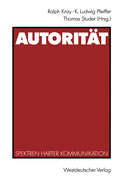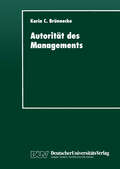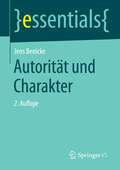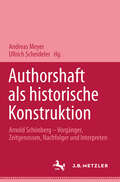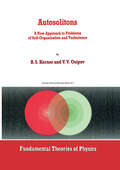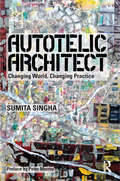- Table View
- List View
Autoritarismus und Gesellschaft: Trendanalysen und vergleichende Jugenduntersuchungen von 1945–1993
by Gerda LedererAutorität des Managements (DUV Sozialwissenschaft)
by Karin C. BrünneckeDie Autorität des Managements befindet sich heute in einem tiefgreifenden Veränderungsprozeß. Die Autorin diskutiert den Wandel in den sozialen Beziehungen zwischen Führungskräften und Mitarbeitern und die damit einhergehende Neubestimmung von Führung in Unternehmen.
Autorität reloaded: Eine Neukonzeption gegen Gewalteskalationen im Polizeidienst
by Susanne Vom HauAutorität ist das Thema dieses Buches. Eskalationen im Polizeidienst, die offenbar im Zuge der Individualisierung eine neue Qualität erreicht haben, erfordern ein Umdenken der Polizei. Das betrifft besonders das antiquierte Autoritätsverständnis der Polizei. Wie aber lässt sich in der offenen Gesellschaft, in der Über- bzw. Unterordnungsverhältnisse als voraufklärerisch gelten, ein Autoritätsanspruch der Polizei aufrechterhalten? Mit dem Ziel, die funktionale Ausrichtung der Polizei in der Gesellschaft den Befindlichkeiten des selbstbestimmten Bürgers im 21. Jahrhundert anzupassen, wird eine Neukonzeption von Polizeiautorität vorgelegt.
Autorität, Staat und Nationalcharakter: Der Zivilisationsprozeß in Österreich und England 1700–1900 (Figurationen. Schriften zur Zivilisations- und Prozesstheorie #2)
by Helmut Kuzmics Roland AxtmannEinübung, Ausübung und Duldung von Macht können von Gesellschaft zu Gesellschaft sehr verschieden sein. Wie kommt es, daß Gentlemen und Puritaner Englands Charakter entscheident geprägt haben, Beamte und Höflinge jedoch die Kultur des alten Österreich? Das vorliegende Buch liefert einen originären Beitrag zur historischen Soziologie der Staatsbildung zwischen 1700 und 1900. Die Autoren ergänzen die Makroperspektive und eine empirisch und theoretisch informierte Soziologie der Emotionen. Sie stellen "Autorität" in ihren historischen Ausprägungen in einen direkten Bezug zu Gefühlen und zum Gefühlsmanagement des einzelnen.
Autorität und Charakter (essentials)
by Jens BenickeJens Benicke untersucht anhand der Theorie der autoritären Persönlichkeit, warum sich Menschen freiwillig Autoritäten unterordnen. Diese Fragestellung soll Aufschluss darüber geben, warum bestimmte Personen anfällig sind für faschistisches Gedankengut. Aufbauend auf den ideengeschichtlichen Voraussetzungen des historischen Materialismus, der Massenpsychologie und der Psychoanalyse wurden in der Theorie spezielle Charaktertypen entwickelt, die aufgrund ihrer frühkindlichen Sozialisation in einer hierarchisch strukturierten, kapitalistischen Gesellschaft zu autoritären Einstellungen neigen. Empirisch nachweisbar wurde dieser potenziell faschistische Charakter durch die F-Skala, die in den „Studien zum autoritären Charakter“ entwickelt wurde. Aus Kritikpunkten an diesem Konzept entwickelten sich später neue Autoritarismustheorien, die hier kurz zusammengefasst werden.
Autorität und Disziplin in der Demokratie (Reden und Aufsätze zur Politik #2)
by Gerhard MöbusIm folgenden wird das Manuskript des Vortrags veröffentlicht, den ich an läßlich meiner Amtseinführung als Direktor bei der Schule der Bundes wehr für Innere Führung durch den Herrn Bundesminister für Verteidi gung am 21. Oktober 1958 im Schloß in Koblenz gehalten habe. Der Vortrag folgte dem Manuskript mit Rücksicht auf die Zeit, die zur Ver fügung stand, unter der Notwendigkeit, das Geschriebene an einigen Stellen verkürzt wiederzugeben. So konnte die Auffassung Malinowskis über den Zusammenhang der Freiheit des Einzelnen mit der Gesellschafts form nur in knapper Zusammenfassung dargelegt werden. Dasselbe gilt für Max Webers Typen der legitimen Herrschaftsform. Anderseits ergaben sich im Vortrag gelegentliche Randbemerkungen, die das Manuskript nicht enthielt und die in der vorliegenden Veröffentlichung als Anmerkung beigegeben sind. Eine solche Randbemerkung enthält die Anmerkung über die Funktion der Uniform. Das Thema selbst konnte nur in den Schwerpunkten seiner Problematik skizziert werden. Die Möglichkeit, einen Hinweis zu geben, in welcher Richtung nach meiner Meinung der Gedankengang an dieser oder jener Stelle weiterzudenken wäre, ist, wie etwa zum Stichwort Autorität, in einer Anmerkung angedeutet. Daß die Thematik des Vortrags es verdient, erörtert und durchdacht zu werden, bestätigte mir die Zahl der Anfragen, die nach dem Vortrag an mich gerichtet worden sind. Im Gedanken daran, in solchem Sinne anzu regen, wird das Manuskript des Vortrags veröffentlicht.
Autorität und Schule: Die empirische Rekonstruktion der Klassenlehrer-Schüler-Beziehung an Waldorfschulen (Studien zur Schul- und Bildungsforschung)
by Werner Helsper Heiner Ullrich Bernhard Stelmaszyk Davina Höblich Gunther Graßhoff Dana JungDie Studie präsentiert zum ersten Mal im deutschsprachigen Raum eine empirische Rekonstruktion der Beziehung zwischen Schülern und Klassenlehrern an Waldorfschulen. Damit wird die Erziehungswirklichkeit zwischen Waldorfklassenlehrern und ihren Schülern in den Mittelpunkt gerückt und ein pädagogisches Konzept, das auf Dauer angelegt ist, umfassende Zuständigkeit reklamiert und auf Autorität und Vorbildwirkung setzt. Die Ergebnisse fördern ein außerordentlich breites Spektrum pädagogischer Beziehungen zu Tage. Diese werden abschließend in den Horizont theoretischer Bestimmungen zur pädagogischen Autorität und Professionalität des Lehrers eingerückt.
Autorité épiscopale et sollicitude pastorale (Variorum Collected Studies)
by Charles MunierThe first set of articles in this collection is concerned with the nature of the bishop’s authority in the Early Church and the sources from which it was drawn. This is seen in political terms, as in the writings of Justin Martyr, as well as spiritual ones. Charles Munier singles out Tertullian as the first to formulate a doctrine of apostolic succession, but also traces his subsequent path towards the affirmation of the authority of the Holy Spirit over that embodied in the ’Orthodox Church’. The following studies turn to a complementary area of ecclesiology, that of pastoral care. The author points to the great diversity of forms of worship and rite, from the earliest days of the Church; these, he argues, reflect a constant process of adaptation, to fit particular religious needs, and to understand such divergences it is necessary to investigate the theological motives that lay behind them. Particular topics here are those of baptism and marriage, especially the still controversial question of how and with what discretion to treat divorce and remarriage. La première série d'articles de cette collection examine la nature et la source de l’autorité des évêques de l’Eglise primitive. Ceci est abordé en termes politiques, au travers d’étude sur Justin le Martyr, ainsi qu'en termes spirituels. Charles Munier, tout en reconnaissant Tertullien pour avoir été le premier à formuler la doctrine de la succession apostolique, retrace aussi la voie parcourue ultérieurement par ce dernier vers l’affirmation de la suprémacie de l’autorité du Saint Esprit sur celle répresentée par l’Eglise orthodoxe. Les études suivantes se tourent vers un domaine complémentaire de l’ecclésiologie, celui de la sollicitude pastorale. L’auteur souligne la grande diversitie de liturgies et de rites qui ont toujours eu cours au sien de l’Eglise; selon lui, on voit là le reflet d'un processus d'adaptation constant, destiné a répondre à des besoins
Autorité épiscopale et sollicitude pastorale (Variorum Collected Studies)
by Charles MunierThe first set of articles in this collection is concerned with the nature of the bishop’s authority in the Early Church and the sources from which it was drawn. This is seen in political terms, as in the writings of Justin Martyr, as well as spiritual ones. Charles Munier singles out Tertullian as the first to formulate a doctrine of apostolic succession, but also traces his subsequent path towards the affirmation of the authority of the Holy Spirit over that embodied in the ’Orthodox Church’. The following studies turn to a complementary area of ecclesiology, that of pastoral care. The author points to the great diversity of forms of worship and rite, from the earliest days of the Church; these, he argues, reflect a constant process of adaptation, to fit particular religious needs, and to understand such divergences it is necessary to investigate the theological motives that lay behind them. Particular topics here are those of baptism and marriage, especially the still controversial question of how and with what discretion to treat divorce and remarriage. La première série d'articles de cette collection examine la nature et la source de l’autorité des évêques de l’Eglise primitive. Ceci est abordé en termes politiques, au travers d’étude sur Justin le Martyr, ainsi qu'en termes spirituels. Charles Munier, tout en reconnaissant Tertullien pour avoir été le premier à formuler la doctrine de la succession apostolique, retrace aussi la voie parcourue ultérieurement par ce dernier vers l’affirmation de la suprémacie de l’autorité du Saint Esprit sur celle répresentée par l’Eglise orthodoxe. Les études suivantes se tourent vers un domaine complémentaire de l’ecclésiologie, celui de la sollicitude pastorale. L’auteur souligne la grande diversitie de liturgies et de rites qui ont toujours eu cours au sien de l’Eglise; selon lui, on voit là le reflet d'un processus d'adaptation constant, destiné a répondre à des besoins
Autorschaft als historische Konstruktion: Arnold Schönberg - Vorgänger, Zeitgenossen, Nachfolger und Interpreten
by Andreas Meyer Ullrich ScheidelerSchönberg zwischen Vergangenheit und Zukunft - die Beiträge des zu Schönbergs 50. Todestag erscheinenden Bandes vermessen den historischen Ort seines Werks von den "klassischen" Ahnen wie Bach über die Zeitgenossen Brahms und Mahler bis zur versteckten Huldigung bei Carter und Rihm.
Autos and Progress: The Brazilian Search for Modernity
by Joel WolfeAutos and Progress reinterprets twentieth-century Brazilian history through automobiles, using them as a window for understanding the nation's struggle for modernity in the face of its massive geographical size, weak central government, and dependence on agricultural exports. Among the topics Wolfe touches upon are the first sports cars and elite consumerism; intellectuals' embrace of cars as the key for transformation and unification of Brazil; Henry Ford's building of a company town in the Brazilian jungle; the creation of a transportation infrastructure; democratization and consumer culture; auto workers and their creation of a national political party; and the economic and environmental impact of autos on Brazil. This focus on Brazilians' fascination with automobiles and their reliance on auto production and consumption as keys to their economic and social transformation, explains how Brazil--which enshrined its belief in science and technology in its national slogan of Order and Progress--has differentiated itself from other Latin American nations. Autos and Progress engages key issues in Brazil around the meaning and role of race in society and also addresses several classic debates in Brazilian studies about the nature of Brazil's great size and diversity and how they shaped state-making.
Autos and Progress: The Brazilian Search for Modernity
by Joel WolfeAutos and Progress reinterprets twentieth-century Brazilian history through automobiles, using them as a window for understanding the nation's struggle for modernity in the face of its massive geographical size, weak central government, and dependence on agricultural exports. Among the topics Wolfe touches upon are the first sports cars and elite consumerism; intellectuals' embrace of cars as the key for transformation and unification of Brazil; Henry Ford's building of a company town in the Brazilian jungle; the creation of a transportation infrastructure; democratization and consumer culture; auto workers and their creation of a national political party; and the economic and environmental impact of autos on Brazil. This focus on Brazilians' fascination with automobiles and their reliance on auto production and consumption as keys to their economic and social transformation, explains how Brazil--which enshrined its belief in science and technology in its national slogan of Order and Progress--has differentiated itself from other Latin American nations. Autos and Progress engages key issues in Brazil around the meaning and role of race in society and also addresses several classic debates in Brazilian studies about the nature of Brazil's great size and diversity and how they shaped state-making.
AutoSketch - Zeichenkurs (Viewegs Fachbücher der Technik)
by Hans Georg Harnisch Volker KüchDieses Buch führt in das Arbeiten mit dem Zeichen-Softwarepaket AutoSketch unter PC- und MS-DOS und in dessen Anwendung beim Erstellen technischer Zeichnungen ein. Die Befehle, Funktionen und grundlegenden Vorgehensweisen werden ausführlich behandelt und an praktischen Beispielen veranschaulicht.
Autosolitons: A New Approach to Problems of Self-Organization and Turbulence (Fundamental Theories of Physics #61)
by B.S. Kerner V.V. OsipovThis monograph is devoted to an entirely new branch of nonlinear physics - solitary intrinsic states, or autosolitons, which form in a broad class of physical, chemical and biological dissipative systems. Autosolitons are often observed as highly nonequilibrium regions in slightly nonequilibrium systems, in many ways resembling ball lightning which occurs in the atmosphere. We develop a new approach to problems of self-organization and turbulence, treating these phenomena as a result of spontaneous formation and subsequent evolution of autosolitons. Scenarios of self-organization involve sophisticated interactions between autosolitons, whereas turbulence is regarded as a pattern of autosolitons which appear and disappear at random in different parts of the system. This monograph is the first attempt to provide a comprehensive summary of the theory of autosolitons as developed by the authors over the years of research. The monograph is comprised of three more or less autonomous parts. Part I deals with the physical nature and experimental studies of autosolitons and self organization in various physical systems: semiconductor and gas plasma, heated gas mixture, semiconductor structures, composite superconductors, optical and magnetic media, systems with uniformly generated combustion matter, distributed gas-discharge and electronic systems. We discuss feasibility of autosolitons in the form of highly nonequilibrium regions in slightly nonequilibrium gases and semiconductors, "hot" and "cold" regions in semiconductor and gas plasmas, static, pulsating and traveling combustion fronts.
Autosoziobiographie: Poetik und Politik (Abhandlungen zur Literaturwissenschaft)
by Eva Blome Philipp Lammers Sarah SeidelAutosoziobiographisches Erzählen hat in der Gegenwartsliteratur Konjunktur. Es hat zum Anspruch, die narrative Darstellung des eigenen Lebens mit der Analyse gesellschaftlicher Problemlagen – oder zumindest deren literarisch verdichteter Beschreibung – zu verbinden. Der Sammelband versteht sich als Reflexion auf die Emergenz dieser neuen Gattung, der Autosoziobiographie, an der die Autor:innen, aber auch wir Forschenden Anteil haben. Die Beiträge diskutieren aktuelle autosoziobiographische Texte und ihre literarhistorischen Kontexte unter den drei Schwerpunkten ‚Literarische Epistemologie des Sozialen‘, ‚Zum Politischen der Form‘ und ‚Transition und Narration‘.
Autotelic Architect: Changing world, changing practice
by Sumita SinghaAutotelic Architect explores how movements towards more self-initiated projects, greater collaboration and design activism have changed how architects and designers are practicing, as well as the kinds of projects they are working on. Similar to the autotelic self that transforms potential problems into enjoyable challenges, the ‘Autotelic Architect’ does not avoid societal changes, but instead learns to harness their creative potential. Using new research and case studies from past and present, the author analyses the educational and professional implications of operating as a ‘non-conventional’ progressive participatory design practice. Drawing on a range of global case studies of pioneering architects in the field, she reflects upon current and future trends at local, national and international level, and additionally examines marketing and practical issues for architects. Illustrated with more than 30 black and white images, this is a compelling read for any practicing architect.
Autotelic Architect: Changing world, changing practice
by Sumita SinghaAutotelic Architect explores how movements towards more self-initiated projects, greater collaboration and design activism have changed how architects and designers are practicing, as well as the kinds of projects they are working on. Similar to the autotelic self that transforms potential problems into enjoyable challenges, the ‘Autotelic Architect’ does not avoid societal changes, but instead learns to harness their creative potential. Using new research and case studies from past and present, the author analyses the educational and professional implications of operating as a ‘non-conventional’ progressive participatory design practice. Drawing on a range of global case studies of pioneering architects in the field, she reflects upon current and future trends at local, national and international level, and additionally examines marketing and practical issues for architects. Illustrated with more than 30 black and white images, this is a compelling read for any practicing architect.
Autotransfusion: Using your own blood
by K. MESSMERThe practice of autologous blood collection and transfusion has been steadily increasing. The concept is not new; however, its application has been limited because of lack of interest and willingness to make the extra effort required. Also there has been concern about the safety of the procedure. Homologous blood transfusion is easy and has allo wed us to salvage lives and perform procedures which would not have been feasible without the availability of whole blood or its components. Transfusion with homologous blood products is safe; however, com plications can and do occur. The transmission of AIDS by transfusion of homologous blood products has significantly increased patient and physician awareness of the dangers one faces. This potential complica tion has promoted autotransfusion. It is now commonly used and reques ted by patients and physicians. Blood for autotransfusion is collected pre or intraoperatively by phle botomy and retrieved intra and post operatively from sites of hemor rhage. Once collected, the blood is either stored or returned to the patient as whole or processed blood. To have a successful autotransfusion program requires anticipation of its needs and coordination and training of involved personel in the blood bank, emergency room, operating room and post-surgical care units. Pre deposit and processing of collected blood requires remission of donor criteria and labeling and storage procedures.
Autotrophic Microbiology and One-Carbon Metabolism: Volume I (Advances in Autotrophic Microbiology and One-Carbon Metabolism #1)
by G. A. Codd L. Dijkhuizen F. Robert TabitaAutotrophic and methylotrophic microorganisms are able to grow at the expense of one-carbon compounds (e.g. carbon dioxide, formaldehyde) as the principal carbon sources for the synthesis of cell material, using light, inorganic compounds or one-carbon compounds as energy sources. The study of the special adaptations required in aerobic and anaerobic microorganisms to sustain an autotrophic or methylotrophic mode of life is a fascinating field of research for scientists from various disciplines. Current research efforts not only focus on fundamental aspects, i.e. metabolic pathways and their regulation, ecology, energy conversion and genetics, but also the possible application of these organisms, in waste water treatment, degradation of xenobiotics, single-cell protein production, as biocatalysts for the production of fine chemicals, draws strong attention. The aim of this series is to provide annual reviews on the biochemistry, physiology, ecology, genetics, and application of microbial autotrophs and methylotrophs. The scope of the series includes all aspects of the biology of these microbes, and will deal with phototrophic and chemolithotrophic prokaryotic autotrophs, carboxydobacteria, acetogenic-, methanogenic- and methylotrophic bacteria, as well as methylotrophic eukaryotes. The exciting advances made in recent years in the study of these organisms is reflected in the chapters of this first volume which have been written by experts in the field. We would like to express our sincere thanks to all the contributors for their stimulating and comprehensive chapters.
Autotrophic Nitrogen Removal from Low Concentrated Effluents: Study of System Configurations and Operational Features for Post-treatment of Anaerobic Effluents (IHE Delft PhD Thesis Series)
by Javier Adrián Sánchez GuillénOn a global scale, sewage represents the main point-source of water pollution and is also the predominant source of nitrogen contamination in urban regions. The present research is focused on the study of the main challenges that need to be addressed in order to achieve a successful inorganic nitrogen post-treatment of anaerobic effluents in the mainstream. The post-treatment is based on autotrophic nitrogen removal. The challenges are classified in terms of operational features and system configuration, namely: (i) the short-term effects of organic carbon source, the COD/N ratio and the temperature on the autotrophic nitrogen removal; the results from this study confirms that the Anammox activity is strongly influenced by temperature, in spite of the COD source and COD/N ratios applied. (ii) The long-term performance of the Anammox process under low nitrogen sludge loading rate (NSLR) and moderate to low temperatures; it demonstrates that NSLR affects nitrogen removal efficiency, granular size and biomass concentration of the bioreactor. (iii) The Anammox cultivation in a closed sponge-bed trickling filter (CSTF) and (iv) the autotrophic nitrogen removal over nitrite in a sponge-bed trickling filter (STF). Both types of Anammox sponge-bed trickling filters offer a plane technology with good nitrogen removal efficiency.
Autotrophic Nitrogen Removal from Low Concentrated Effluents: Study of System Configurations and Operational Features for Post-treatment of Anaerobic Effluents (IHE Delft PhD Thesis Series)
by Javier Adrián Sánchez GuillénOn a global scale, sewage represents the main point-source of water pollution and is also the predominant source of nitrogen contamination in urban regions. The present research is focused on the study of the main challenges that need to be addressed in order to achieve a successful inorganic nitrogen post-treatment of anaerobic effluents in the mainstream. The post-treatment is based on autotrophic nitrogen removal. The challenges are classified in terms of operational features and system configuration, namely: (i) the short-term effects of organic carbon source, the COD/N ratio and the temperature on the autotrophic nitrogen removal; the results from this study confirms that the Anammox activity is strongly influenced by temperature, in spite of the COD source and COD/N ratios applied. (ii) The long-term performance of the Anammox process under low nitrogen sludge loading rate (NSLR) and moderate to low temperatures; it demonstrates that NSLR affects nitrogen removal efficiency, granular size and biomass concentration of the bioreactor. (iii) The Anammox cultivation in a closed sponge-bed trickling filter (CSTF) and (iv) the autotrophic nitrogen removal over nitrite in a sponge-bed trickling filter (STF). Both types of Anammox sponge-bed trickling filters offer a plane technology with good nitrogen removal efficiency.
Autotuning of PID Controllers: Relay Feedback Approach (Advances in Industrial Control)
by Cheng-Ching YuRecognising the benefits of improved control, this book aims to provide simple and yet effective methods of improving controller performance. It bridges the gap between the conventional tuning practice and new generations of autotuning methods. Practical issues facing controller tuning are treated, such as measurement noises, process nonlinearity, load disturbances, and multivariable interaction, and tools are also given. Numerous worked examples and case studies are used to illustrate the autotuning procedure, and MATLAB programs to execute autotuning steps are given. This book is intended to be an independent learning tool, and is particularly invaluable to practitioners and scientist, as well as graduate and undergraduate students. The reader will therefore find it useful, particularly as it is applicable to engineering practice
Autotuning of PID Controllers: A Relay Feedback Approach
by Cheng-Ching YuRecognising the benefits of improved control, the second edition of Autotuning of PID Controllers provides simple yet effective methods for improving PID controller performance. The practical issues of controller tuning are examined using numerous worked examples and case studies in association with specially written autotuning MATLAB® programs to bridge the gap between conventional tuning practice and novel autotuning methods. The extensively revised second edition covers: • Derivation of analytical expressions for relay feedback responses. • Shapes of relay responses and improved closed-loop control and performance assessment. • Autotuning for handling process nonlinearity in multiple-model-based cases. • The impact of imperfect actuators on controller performance. This book is more than just a monograph, it is an independent learning tool applicable to the work of academic control engineers and of their counterparts in industry looking for more effective process control and automation.

